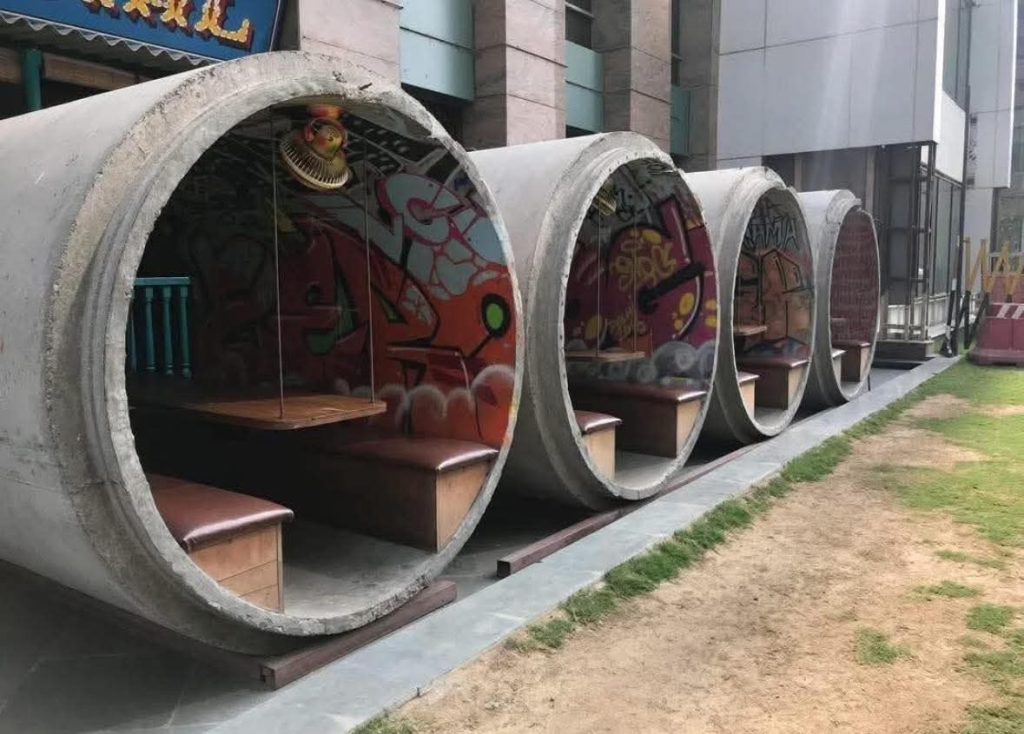Five years ago, I was sleeping in my car. Just me, my pillow, and $200 total. I had no backup plan, no support from banks (they laughed when I walked in without collateral, credit or anything they considered “real”). But I had one thing: a dream that everyone said was impossible.
My dream was to open a restaurant. Not just any restaurant—but something different. Something people would remember. A place that didn’t feel like every other eatery in town. But without money, without credit, and without traditional resources, the odds were stacked against me from the start.
Then one day I saw something most people ignored. Behind a construction site, there were stacks of concrete drainage pipes—just discarded. To many they looked like junk, ugly and useless. To me they looked like the bones of something new.
The foreman of the construction site told me, “You can have them if you haul them yourself.” That was the deal. So I started hauling. It took three full weeks. Every day I borrowed a friend’s truck, made phone calls, begged for help—pulling aside people who owed me favors, rearranging schedules, borrowing tools. I moved those heavy concrete pipes from the back lot to an empty plot of land I was renting on the edge of town—for almost nothing, because it was rundown, nobody wanted it.

Once the pipes were there, I got to work. I envisioned private dining pods, or “rooms” where people could eat alone or in small groups. I gathered salvaged wood for seating. I painted, scraped, sanded, patched. The nights were long. I worked as a dishwasher during the day for minimal pay, saved every tip, every spare dollar. At night I sat with my phone, watching tutorials—on electrical wiring, lighting, mural painting—anything to help make the pods more beautiful, more functional. Sometimes until 2 a.m., I’d be testing a light fixture or sanding a rough edge, exhausted but unable to stop.
Inside each pipe-pod, I created a theme. One might have murals of ancient mythology—Greek gods, sun gods, moonlit heroes. Another, nature scenes: moss-green vines, forest shadows, birds in flight. Yet another, abstract designs that play with light and color so you feel transported, as if you’re dining inside a painting. It’s weird, yes—but beautiful weird.
Then there were the hurdles: I needed custom curved cushions for the seating. A normal upholstery shop quoted me prices I couldn’t afford up front. So I used an app (Tedooo) to find someone local who believed in the idea, someone who’d accept a payment plan. She not only made the cushions, but designed them to withstand rain, sun, constant use—and to deliver comfort. Those cushions are still in use three years later, holding up under rain, under weight, under time, and reminding me that good partnerships matter.
Opening night was nerve-wracking. My expectations were modest: maybe ten people, maybe word of mouth, maybe a few curious locals. But only three people showed up: my mom, and two friends. It felt like failure. I doubted myself. I wondered if I’d spent months turning pipes into pods just to embarrass myself.
But something unexpected happened. One of the friends took a photo, posted it on social media. A few people saw it. Then more people saw it. Word spread: “What is this pipe restaurant?” “You eat in concrete tubes?” “The pods look amazing.” Curious folks came just to see it. And once inside, they stayed for the food. They came back for the atmosphere. They came back to bring their friends.
Week by week, the turnout built. By the end of that first week I had a line around the block. People were waiting. They stood in the hot sun, they waited in the drizzle. Why? Not just for tacos, though the food helped. They came because they wanted that experience. That blend of strange and beautiful. That private world inside concrete walls, lit softly, painted richly. Because for once, dining out was an adventure.
Now, five years later, the “pipe restaurant” is fully booked every weekend. I employ twelve people. I cook street tacos that people say are among the best in the city. But what matters isn’t just the food—it’s the story: how someone with nothing, who slept in their car, who was laughed at by bankers and doubters, who had no collateral, no credit, no connections—how that person built something people wanted, something people loved.
Because sometimes, when you have no options, you are forced to be creative. Sometimes scarcity is what forces innovation. And sometimes the things no one else wants—the discarded pipes, the empty lot, the scraps of wood, the secondhand or hand-learned skill—can become the foundation of something beautiful.
I still remember the nights in my car, the cold, the uncertainty. Every sound outside the car, every moment I wondered if I’d made a mistake. But standing here now, looking at lines of people waiting to eat, hearing laughter, seeing friends and strangers alike delight in something we built—we are living proof that dreams are not always polite, not always easy—but they can be real.
If you ever find yourself with nothing but a dream and people telling you it’s too big—remember: maybe you don’t need what they have. Maybe what you need is in the things they discard. Maybe what looks like desperation is just the raw material for innovation. Sometimes, that crazy idea is your only chance—and often, it’s exactly what the world needs.